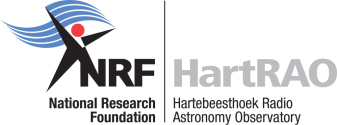
HartRAO Home >
Astronomical VLBI at HartRAO
Astronomical VLBI at HartRAO
The Very Long Baseline Interferometry (VLBI) Technique
The radio telescope at Hartbeesthoek regularly operates as part of arrays of
radio telescopes around the Earth and in space. When operating in this way,
data are recorded simultaneously from each object at the same time at each
telescope. The data streams from the telescopes are correlated later by
computer. The interference pattern observed between the signals recorded at
each pair of telescopes allows the brightness distribution of the radio
source to be reconstructed and an image of it created. An example is shown
below. The larger the "virtual telescope" created by this technique, i.e.
the further apart the individual telescopes are, the finer the detail that
can be seen in the radio source. Details with an angular size of one
millionth of a degree can typically be seen.
In 2008 May, the first e-VLBI experiments were conducted in which the 26m
telescope at Hartebeesthoek was linked directly to a correlator in Europe,
together with telescopes on other continents, to produce real-time VLBI.
Astronomical VLBI observations at HartRAO
For astronomical VLBI HartRAO operates as part of a number of networks
covering:
- Europe - the European VLBI Network -
EVN
- Australia - the Australia Telescope - Long Baseline Array -
AT-LBA
- Global Array - the EVN +
US VLBA + others
- Space VLBI with orbiting radio telescope
Radioastron and other
ground-based radio telescopes.
- Astrometric and geodetic VLBI data may also be processed for information
on changes in the structure of the quasars that are the targets in these
experiments. The IVS Live
website allows the progress of these experiments to be followed in real time.

The map above illustrates the VLBI networks.
Click on the image for a large version.
VLBI instrumentation at HartRAO
All the installed receivers on the 26m telescope at HartRAO are
VLBI-capable, as is th econecentric SX band reciever on the 15m telescope.
Local oscillator systems phase-locked to a hydrogen maser frequency standard
- there are three available, providing backup. The MkIIIA VLBI recording terminal was
upgraded to Mk5 standard. Two Digital Baseband Converters (DBBC's) are in
use, and data are recorded on disk packs in two Mark 5B+ recorders. The two
telescopes can run VLBIs in parallel. A third
Mark 5B+ is used for diskpack conditioning and e-shipment of VLBI data. There
is a 10 Gb/s international network connection for real-time eVLBI and for
e-shipment.
VLBI observations of Centaurus A
The giant elliptical galaxy NGC5128 in the southern constellation of
Centaurus produces radio-emitting jets of hot gas. The galaxy is the
brightest radio emitting object in the constellation, and hence is also
known as "Centaurus A". The jets are thought to
emerge from around a black hole with a mass of some billion solar masses.
The gravity of the black hole draws in nearby stars and gas, which provide
the fuel for the jet. It provides an example of what can be observed with
the VLBI technique. HartRAO has been involved in a number of VLBI
experiments to look at the details of the structure of the jet, and changes
in the structure over time.

|
|---|
Optical image of NGC5128. The dust belt is from
a galaxy that has recently merged with NGC5128. The dust hides the black
hole. The picture has an angular extent on the sky of about one quarter of
a degree, or half the angular size of the moon.

|
|---|
The radio-emitting jets from the galaxy cover
nearly ten degrees on the sky, or twenty times the angular size of the moon.
They extend far outside the galaxy we see optically. This image showing the
full length of the jets was made with the Hartebeesthoek telescope at a
frequency of 2326 MHz in the 13 cm wavelength band. It shows detail down to
one third of a degree, the beamwidth of the telescope at that wavelength.
The optical image would fit within the white patch in this image.
Image courtesy of Justin Jonas, Rhodes University phjj@hippo.ru.ac.za

|
|---|
In this VLBI image we see fine details of the
upper jet as it leaves the area around the black hole, which is in the
centre of the image. This part of the jet is about one hundred thousandth
of a degree long, and we see details smaller than a millionth of a degree.
Only one "hot spot" is seen in the fainter counterjet which points to the
lower right. This picture was made using a world wide array of radio
telescopes that included the Hartebeesthoek telescope.
Image courtesy of Steven Tingay, Jet Propulsion Laboratory tingay@hyaa.jpl.nasa.gov.
For more information see: Jones et al. (1996) Astrophysical Journal,
466, L63-L65 and Tingay et al. (1998) Astronomical Journal, 115,
960-974.
Space VLBI
Hartbeesthoek participated in the space VLBI programme with VSOP/HALCA,
the Japanese radio telescope that orbited the Earth. Examples of the extremely high
angular resolution obtained with a telescope in space that reaches altitudes
of up to 21 000 km are shown at the VSOP Image
Gallery. This mission has completed.
The Russian Radioastron orbiting radio telescope became operational in
2012. To obtain sufficient sensitivity it usually needs ground-based
telescopes of 50m diameter or more, but the HartRAO 26m telescope has also
participated in VLBI with Radioastron.





